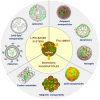Nanomedicine for the Delivery of RNA in Cancer
- PMID: 35681657
- PMCID: PMC9179531
- DOI: 10.3390/cancers14112677
Nanomedicine for the Delivery of RNA in Cancer
Abstract
The complexity, and the diversity of the different types of cancers allied to the tendency to form metastasis make treatment efficiency so tricky and often impossible due to the advanced stage of the disease in the diagnosis. In recent years, due to tremendous scientific breakthroughs, we have witnessed exponential growth in the elucidation of mechanisms that underlie carcinogenesis and metastasis. The development of more selective therapies made it possible to improve cancer treatment. Although interdisciplinary research leads to encouraging results, scientists still have a long exploration journey. RNA technology represents a promise as a therapeutic intervention for targeted gene silencing in cancer, and there are already some RNA-based formulations in clinical trials. However, the use of RNA as a therapeutic tool presents severe limitations, mainly related to its low stability and poor cellular uptake. Thus, the use of nanomedicine employing nanoparticles to encapsulate RNA may represent a suitable platform to address the major challenges hampering its therapeutic application. In this review, we have revisited the potential of RNA and RNA-associated therapies to fight cancer, also providing, as support, a general overview of nanoplatforms for RNA delivery.
Keywords: RNA; cancer; drug delivery systems; nanoparticles.
Conflict of interest statement
The authors declare no conflict of interest.
Figures
References
Publication types
Grants and funding
LinkOut - more resources
Full Text Sources




